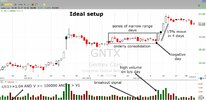Stocks move in momentum burst of 3 to 5 days. You can use this stock's tendency to your advantage. Look for these following:
Essentially if you look for top gainers in the day (mostly focus on the ones that are up and over 4% - this is the range expansion day if you look at the candle. In this day volume must be higher than previous day.
To support this the previous day the stock should have a narrow range or even better if its a down day.
The stock can have 3-20 days of consolidation prior to this range expansion day.
On the range expansion day the stock must close near its high.
Stock should be in an uptrend (supported by being any of the simple moving averages say 10 or 20 days or even 50 days)
The stock chart should not be sideways but a linear uptrend must be noticeable.
In 3-5 days, stocks identified using the above rules can make 8 to 40% in 3 to 5 days. For higher priced stocks, typically over 40$ they move in 5 to 25$ bursts.
Try to observe this set up and if you post charts I can pass my feedback. This is one of the simple set ups I use for swing trading.
Essentially if you look for top gainers in the day (mostly focus on the ones that are up and over 4% - this is the range expansion day if you look at the candle. In this day volume must be higher than previous day.
To support this the previous day the stock should have a narrow range or even better if its a down day.
The stock can have 3-20 days of consolidation prior to this range expansion day.
On the range expansion day the stock must close near its high.
Stock should be in an uptrend (supported by being any of the simple moving averages say 10 or 20 days or even 50 days)
The stock chart should not be sideways but a linear uptrend must be noticeable.
In 3-5 days, stocks identified using the above rules can make 8 to 40% in 3 to 5 days. For higher priced stocks, typically over 40$ they move in 5 to 25$ bursts.
Try to observe this set up and if you post charts I can pass my feedback. This is one of the simple set ups I use for swing trading.

